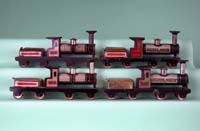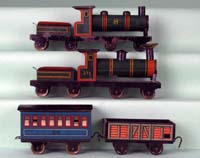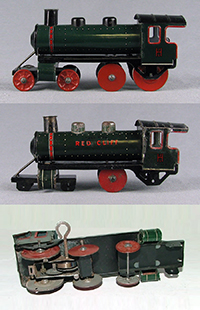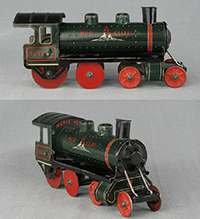 |
||||
|---|---|---|---|---|
 |
A group of 575 gray boiler locomotives - all early manufacture. After a period of time it appears that Hess decided that red was a better color (until they changed it much later to green). | |||
 |
Hess 575 boxed set, circa late 1920s A small boxed, later manufactured set consisting of green bodied locomotive, blue passenger car and open gondola. Note the cutout on the bottom of the locomotive boiler for some models to accept clockwork. |
|||
 |
A small 575, green bodied locomotive with a second varying 575 loco. Notice the top loco with two steam domes, JLH logo and no numeric identification while the bottom loco has one steam dome, 575 numbered and no logo. The bottom loco’s boiler bottom has been cut out to accept clockwork, top loco has short stack without a flare, bottom loco has tall flared stack. As I mentioned previously, much minor variety in all that Hess produced. | |||
 |
Hess last produced locomotive, circa 1930s L 6” (15.3 cm), W 1.75” (4.5 cm), H 2.6” (6.7 cm) Pictured is the last produced locomotive by Hess. The top loco is only marked with the “JLH” logo. The bottom loco is marked “Red Cliff”, “Hess Roller”, the “JLH” logo and “Marke”. The Red Cliff loco was possibly a special order and / or it may have been named after the Colorado town of Red Cliff and its railway. The Red Cliff railway was an extension of the Denver and Rio Grande lines in 1881. If made for the American market, I am surprised there is no cowcatcher. Bottom photo shows this locomotive equipped with clockwork, but all versions are very hard to find. Hess item number 1032 in their distributor catalog. |
|||
 |
Hess “Red Cliff” Locomotive, circa early 1900s L 6” (15.3 cm), W 1.75” (4.5 cm), H 2.6” (6.7 cm) Coming to me from Oxelosund, Sweden is this toy from the son of the original owner. This “Red Cliff” version may be an uncataloged special order for the American market. Both the “JLH” and “H” shield logos are on the front of the engine making this piece very early 1900s production. This locomotive was also produced without the Red Cliff graphic until the close of business in 1934. Marking with both logos was only common in the early 1900s when Johann Hess was taking over the company from his father, Matthias. Other markings included are “Marke Hess”, “1032”, “Red Cliff” and an unusual graphic of what seems to be a red cliff next to a river on the side of the boiler. This model is a flywheel powered example, but simple push power and clockwork models were also produced over this loco’s lifetime. This piece is named after the Colorado town of Red Cliff with it’s 1881 rail extension. The red cliff graphic printed on the boiler representing the red quartzite cliff next to the river.
|
|||

